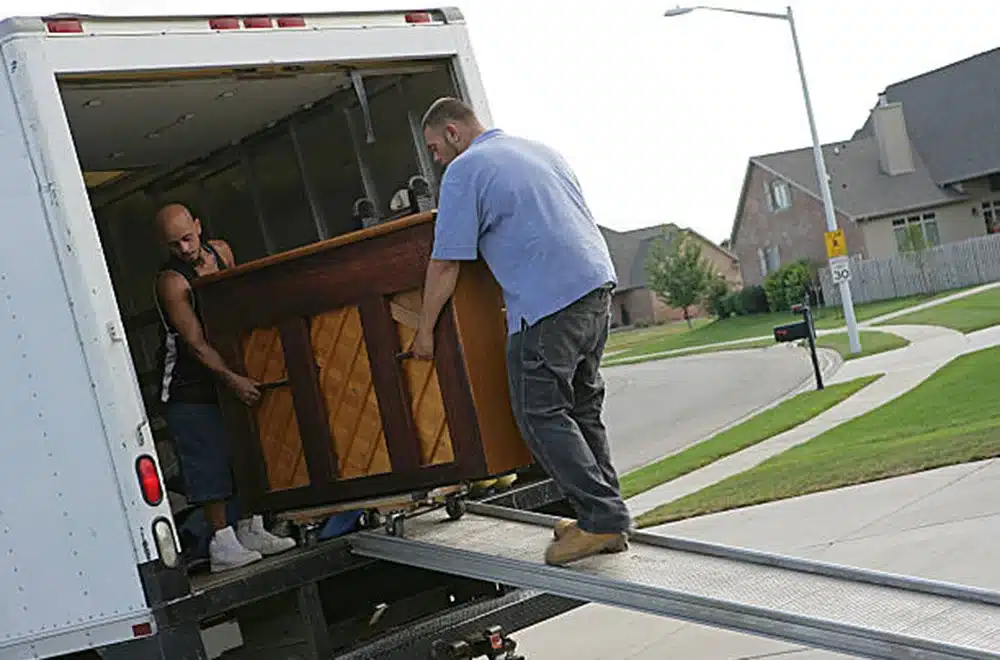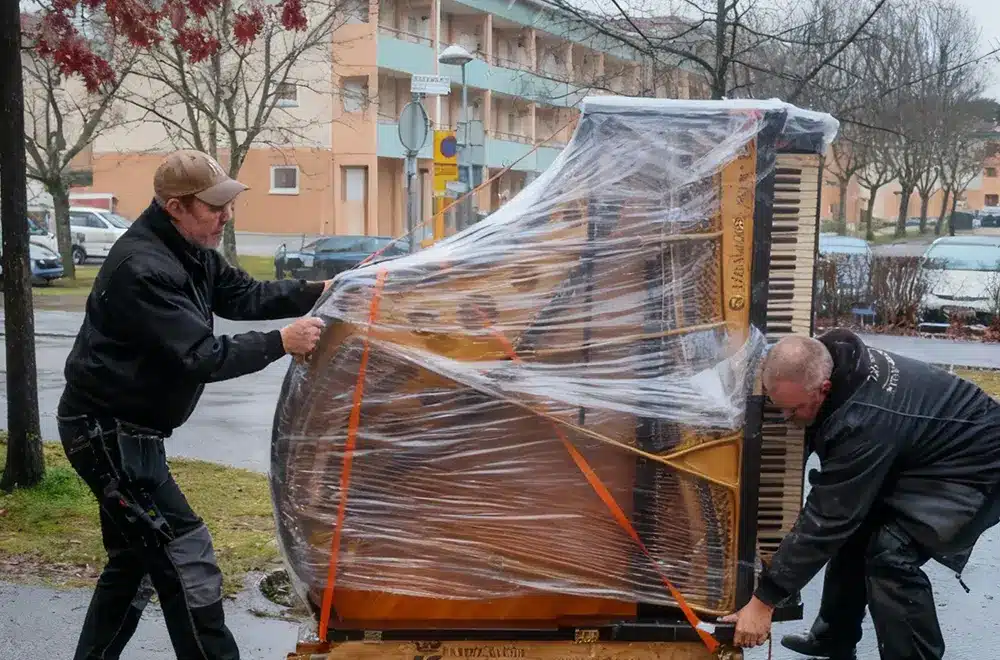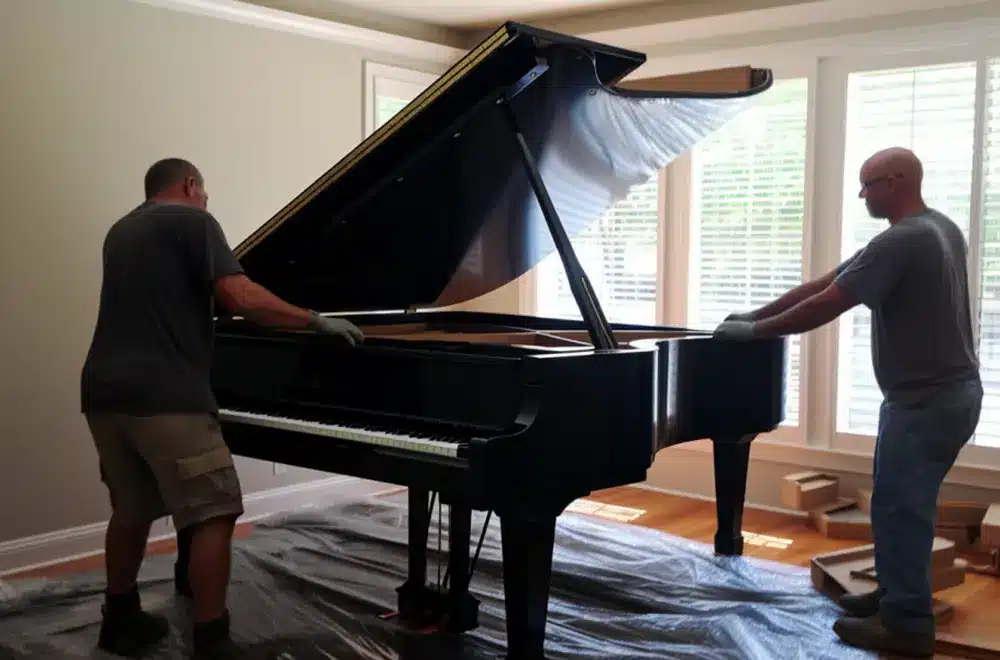Think moving a piano is just about lifting? Think again. Pianos are among the trickiest items to move because of their sheer size, weight, and fragility. Without the right techniques, even a short move can result in cracked wood, broken legs, or costly damage that exceeds the cost to move a piano itself. That’s why proper piano transport isn’t only about strength; it also requires preparation, precision, and skill. This guide will walk you through how to pack a piano for moving the right way, using the same methods professional movers rely on to keep instruments safe. Whether you’re a homeowner, a musician, or someone considering moving a piano yourself, these step-by-step tips will help you plan, pack, and protect your piano like a pro.
Why Moving a Piano Requires Special Preparation
A piano is far more than a piece of furniture; it’s a fragile, finely tuned instrument with thousands of moving parts. Even the smallest upright models can weigh over 400 pounds, while grand pianos often exceed 1,000 pounds. That weight, combined with intricate craftsmanship, makes piano transport uniquely challenging.
The risks of moving a piano improperly are serious. A cracked soundboard can ruin tone quality permanently, broken legs can leave the piano unstable, and even a slight bump can throw strings or hammers out of alignment. Standard moving techniques that work for couches or cabinets simply don’t protect an instrument of this complexity. The consequences of poor packing can be severe: permanent damage, expensive repairs, or even injuries to those doing the lifting. That’s why following professional piano wrapping techniques and preparation steps is essential when moving.
Step-by-Step: How to Pack a Piano for Moving
Before you begin, remember that packing a piano safely is all about preparation, protection, and precision, especially when you plan to relocate. Here’s the process professionals follow:
1. Gather the Right Supplies
The right tools make all the difference in piano transport. Heavy-duty moving blankets are needed to cushion every surface, while stretch wrap keeps padding in place, and strong packing tape secures layers. A piano skid board is essential for grand pianos, and a sturdy dolly works best for upright models. High-quality moving straps are also necessary to stabilize the instrument during lifting and transit. Personal safety gear matters too when moving a piano yourself: gloves protect your hands, and non-slip footwear helps you stay steady while handling the weight.
2. Secure the Lid and Keyboard
The keyboard is one of the most delicate parts of any piano. Before wrapping the body, close the lid completely. If your piano has a lock, secure it to keep the keys protected. For models without locks, gently tape the lid using painter’s tape that won’t damage the finish. Next, wrap the entire keyboard area in thick padding to absorb impact during the move. This step prevents accidental pressure on the keys and pedals, which could lead to lasting internal damage.
3. Wrap the Piano Entirely
Once the lid is secured, it’s time to wrap the whole instrument. Use multiple layers of thick moving blankets, making sure every side, corner, and fragile edge is protected. Secure the blankets tightly with stretch wrap and tape so they won’t shift in transit. Pay extra attention to legs and corners, as these are the most vulnerable to dents or scratches. When done correctly, this wrapping acts as a shock absorber against bumps and vibrations along the way.
Special Considerations for Upright vs Grand Pianos
Not all pianos are the same. The strategy for moving an upright piano differs from moving a grand, and knowing these differences can help you avoid costly mistakes.
Upright Piano Transport
Upright pianos are generally easier to move since they don’t require full disassembly. However, their tall, narrow design makes them top-heavy and prone to tipping. A strong dolly is essential for stability, and at least two movers should be present to keep the piano balanced. When transporting an upright, always tilt carefully and avoid sudden movements that could shift the internal components.
Grand Piano Transport
Grand pianos require extra care because of their size and design. Unlike uprights, they almost always need partial disassembly. The lid, pedals, and legs should be removed and wrapped separately by your piano moving company, with each piece labeled to simplify reassembly later. Once disassembled, the main body of the grand is tilted onto a padded piano skid board, secured with straps, and lifted by at least two experienced movers. This method ensures the weight is evenly distributed and lowers the risk of breakage.
How to Transport the Piano Safely

Packing is only half the battle. Loading and transporting the piano correctly requires just as much precision. Always use a sturdy ramp or lift gate to move the piano onto the truck instead of relying on brute force, as this is where most injuries and damage happen. Once inside, position the piano snugly against the truck wall and surround it with padding to prevent contact with other objects. Heavy-duty straps are essential to keep the piano secure, reducing the risk of sliding or tipping during sharp turns or sudden stops.
Climate control is another important factor, especially in Houston, where heat and humidity can quickly affect a wooden instrument. If the move takes several hours, avoid direct sunlight exposure, limit the piano’s time outdoors, and, if possible, use a truck with climate protection provided by your moving company. These steps help preserve the piano’s structural integrity and tuning stability, ensuring it arrives in excellent condition.
When to Leave It to the Professionals
While DIY piano moving tips can help with preparation, there are situations where hiring professionals is the smartest choice. If your move involves stairs, narrow hallways, or long distances, the risk of damage rises significantly without the proper experience and equipment. Antique and high-value pianos require even greater caution from your piano moving services, as a single scratch or structural shift can significantly reduce their value. Professional movers are trained to handle these instruments with the specialized care they deserve. And if you don’t have access to a piano skid board, a strong dolly, or enough manpower, taking on the job yourself is not worth the risk.
This is where the team at Piano Movers of Houston comes in. With years of experience, industry-grade equipment, and a focus on careful handling, we ensure your piano reaches its new home safely. Wondering why so many homeowners trust us? Check out our page on Why Hire Piano Movers in Houston for the full breakdown.
Let our pros handle the heavy lifting — get a quote today!
FAQs About Piano Packing and Transport
Can I move a piano without professional help?
Yes, but it’s risky. Smaller upright pianos can sometimes be moved with enough manpower and the proper equipment. However, grand and high-value pianos, including antiques, almost always require professional movers.
What equipment do professional piano movers use?
Professionals rely on specialized tools such as a piano skid board, padded blankets, straps, dollies, ramps, and lift gates. This equipment provides stability and protection that standard moving tools cannot.
Do I need to remove the piano legs before moving?
For grand pianos, yes. The legs, pedals, and lid should be removed and wrapped separately. Upright pianos, however, are typically moved with their legs attached.
How much does it cost to transport a piano?
Costs vary based on distance, piano type, and the complexity of the move. In Houston, local piano transport generally ranges from $200 to $600, while long-distance or specialty moves may cost more. To know exactly what to expect, request a personalized quote from Piano Movers of Houston.
Will my piano need to be tuned after moving?
Most likely. Even with careful handling, changes in environment and vibrations during transport often affect tuning. Scheduling a post-move tuning will ensure your piano sounds its best again.
Related Posts

How to Move a Piano in Houston’s Extreme Weather Conditions

Discover How to Pack & Transport a Piano Like a Pro
